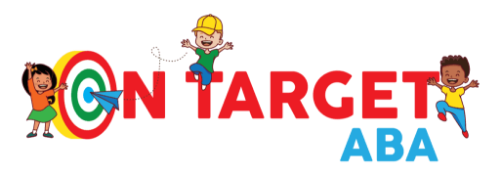🧠 AI Summary:
This blog gives parents an inside look at what really happens during ABA therapy sessions — from the first meeting to goal setting, play-based learning, and progress tracking. It breaks down each stage of therapy, explains common ABA techniques, and reassures families about what to expect. The article also highlights how On Target ABA ensures every session is welcoming, child-centered, and backed by collaboration between therapists and families.
Introduction: Understanding the Journey Ahead
Starting therapy can feel like a big step — especially when you’re unsure what to expect. Parents often ask, “What exactly happens during an ABA session?” or “How will my child respond?”
At On Target ABA, we know that knowledge brings comfort. Our goal is to make sure every parent understands the ABA therapy process — from the first hello to the first big milestone.
This guide walks you through what to expect during your child’s journey, how we make learning fun, and why every session is a step toward growth and confidence. 🌈
What to Expect in ABA Therapy: The First Step
Every journey begins with understanding your child’s unique strengths, challenges, and needs.
During the initial assessment, a Board Certified Behavior Analyst (BCBA) will:
- Observe your child in a natural environment
- Ask about routines, communication, and behaviors
- Identify goals in key areas like communication, social skills, and independence
This information forms your child’s personalized Behavior Intervention Plan (BIP) — the roadmap for therapy.
The Start of Therapy: Meeting the Team
Your child’s therapy team usually includes:
- A BCBA who designs and monitors the program
- A Registered Behavior Technician (RBT) who works one-on-one with your child
- The parent(s) — the most important partners in progress
At On Target ABA, we take time to build rapport first. A child who feels comfortable and safe will learn more effectively. The first few sessions often focus on pairing — building trust through play, laughter, and positive interaction.
Inside a Typical ABA Therapy Session
A typical session is structured but flexible — balancing learning with fun and sensory-friendly breaks.
Here’s what a day might look like:
1. Warm Welcome and Review
Therapist and child begin with a greeting and review of what’s been learned.
Example: “Hi, Sam! Yesterday you practiced colors — let’s see what you remember!”
2.Skill Building Activities
Therapists use proven ABA methods like:
- Discrete Trial Training (DTT): breaking down skills into small steps
- Natural Environment Teaching (NET): learning through play and daily routines
- Task Analysis: step-by-step teaching for self-help skills like brushing teeth
3.Reinforcement and Motivation
Positive reinforcement (praise, playtime, or a favorite toy) keeps children engaged. It helps them connect success with confidence.
4.Data Collection and Progress Notes
Therapists record responses and track behavior data in real time. This allows BCBAs to adjust teaching strategies for maximum growth.
5.Sensory and Movement Breaks
Breaks are built in for regulation — like jumping, swinging, or quiet time. This ensures balance and prevents overwhelm.
6.Session Wrap-Up and Parent Review
Each session ends with a short summary. Parents get updates on progress, new skills, and what to practice at home.
What Makes Each ABA Session Unique
No two sessions look alike — and that’s intentional. Every program is personalized to your child’s goals, strengths, and comfort level.
Some sessions might focus on communication and turn-taking, while others work on emotional regulation or transitions.
Our therapists adjust the pace to match your child’s learning style — whether that means moving quickly through new concepts or taking time to celebrate small victories.
Parent Participation: The Key to Success
Parents are vital members of the therapy team.
During or after sessions, On Target ABA therapists provide:
- Coaching on using reinforcement at home
- Strategies for managing behaviors in daily routines
- Updates on goals, challenges, and next steps
When parents and therapists work together, consistency builds momentum — and that’s where real transformation happens.
Common ABA Techniques You’ll See in Action
| Technique | What It Does | Example |
|---|---|---|
| Positive Reinforcement | Encourages good behavior | Child earns playtime for using words to request |
| Prompting and Fading | Builds independence | Therapist models “say hi” → gradually removes prompt |
| Shaping | Teaches complex behaviors | Rewarding steps toward brushing teeth |
| Task Analysis | Breaks skills into steps | Putting on shoes, washing hands |
| Generalization | Transfers learning to new settings | Saying “thank you” at home and school |
Each strategy is carefully chosen and monitored to ensure learning feels natural and empowering.
How Long Is an ABA Session?
Sessions vary depending on goals and the child’s needs — typically between 2 to 4 hours several days a week.
Therapists balance structured teaching with free play, movement, and sensory exploration to maintain engagement.
💙 The goal isn’t perfection — it’s progress through consistent, positive learning.
💙 The On Target ABA Difference
At On Target ABA, we go beyond data — we build relationships.
✨ Compassionate Teamwork: Therapists meet every child with patience and positivity.
✨ Family Collaboration: Parents are informed, trained, and celebrated every step of the way.
✨ Dynamic Progress Tracking: Data is meaningful — guiding growth, not defining it.
✨ Joyful Learning: Every session includes play, smiles, and heart.
Whether at home or in our centers across Ohio and Utah, we make ABA therapy a positive experience for the entire family. 🌈
Conclusion: Your First Day Is the Start of Something Amazing
Starting ABA therapy is a big decision — and a hopeful one. Every session brings your child closer to communication, confidence, and independence.
At On Target ABA, we’re honored to walk this journey with you — from day one to every milestone that follows. 💙

